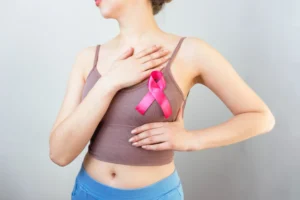Breast Cancer Treatment in Turkey
The techniques and methods used to treat breast cancer in Turkey include the following:
- Radiation therapy
- Surgical procedures
- Chemotherapy
- Stem cell therapy
- Hormone therapy
- Robotic surgery using the Da Vinci surgical system
Cost of Breast Cancer Treatment in Turkey:
- Average cost: $8,500
- Lowest cost: $2,100
- Highest cost: $21,000
If you are interested in traveling for breast cancer treatment in Turkey, please contact us, and we will guide you to the best specialized hospitals with the highest success rates and the lowest possible treatment costs. All you need to do is get in touch with us.

Get a Medical Diagnosis
Video about the treatment stages in Turkey
In the video, you will find details related to treatment in Turkey and how we can assist you.
Health Information Regarding Breast Cancer
What is Breast Cancer?
Breast cancer is a type of cancer that starts in the breast. It occurs when cells begin to grow uncontrollably. Breast cancer cells typically form a lump, which can usually be seen on X-rays or felt as a mass. While breast cancer almost exclusively affects women, men can also develop it.
It is important to understand that most breast lumps are benign (non-cancerous), not malignant (cancerous). Benign breast lumps are abnormal growths but do not spread outside the breast. Although they are not life-threatening, some benign conditions can increase the risk of breast cancer. Any lump or change in the breast should be examined by a healthcare professional to determine whether it is benign or malignant (cancerous) and to assess if it increases future cancer risk.
Types of Breast Cancer:
Different types of breast cancer include:
- Ductal carcinoma in situ
- Invasive ductal carcinoma
- Paget’s disease of the breast
- Angiosarcoma
Causes of Breast Cancer:
Breast cancer occurs when some breast cells start growing abnormally. These cells divide more quickly than healthy cells and continue to accumulate, forming a mass. The cells may spread (metastasize) from the breast to the lymph nodes or other parts of the body.
Breast cancer typically starts in the milk ducts (invasive ductal carcinoma). It may also begin in the glandular tissue called lobules (invasive lobular carcinoma) or in other tissues within the breast.
Hormonal factors, lifestyle choices, and environmental factors may increase the risk of breast cancer. However, it is unclear why some people with no risk factors develop cancer, while others with risk factors never do. It is likely that breast cancer results from a complex interaction between genetics and environmental factors.
Risk Factors for Breast Cancer:
Risk factors for developing breast cancer include:
- Gender (women are more likely to develop breast cancer than men)
- Age (the risk increases with age)
- Personal history of breast cancer
- Family history of breast cancer
- Inherited gene mutations that increase cancer risk
- Radiation exposure
- Obesity
- Early onset of menstruation
- Late menopause
- Having the first child at an older age
- Not having children
- Hormone therapy after menopause
- Alcohol consumption
Symptoms of Breast Cancer:
Symptoms may include:
- A lump in the breast
- Swelling of the entire or part of the breast
- Skin irritation
- Breast pain
- Pain in the nipple or retraction inward
- Redness, flaking, or thickening of the skin of the breast or nipple
- Discharge from the nipple
- A lump under the arm
Breast Cancer Diagnosis Methods:
Tests used to diagnose breast cancer include:
- Breast Exam: The doctor examines both breasts and the lymph nodes under the armpits for lumps or unwanted signs.
- Mammogram: An X-ray of the breast used to detect potential tumors and any changes in breast tissue.
- Breast Ultrasound: This high-frequency ultrasound allows for images of the internal structure of the breast.
- Breast Biopsy: A biopsy is the only definitive way to diagnose breast cancer. During a biopsy, a special needle guided by X-ray or another imaging test extracts tissue from the suspicious area. Often, a small metal marker is left in place so that the area can be easily identified in future imaging tests.
- MRI (Magnetic Resonance Imaging): MRI is used to create images of the interior of the breast.
Breast Cancer Treatment Methods:
Treatment options for breast cancer include:
- Lumpectomy: In this surgery, the surgeon removes the tumor and a small portion of surrounding healthy tissue.
- Mastectomy: This procedure involves removing all breast tissue, including the lobules, ducts, fatty tissue, and some skin, including the nipple and areola (total or simple mastectomy).
- Removal of a limited number of lymph nodes: To check if cancer has spread to lymph nodes, a limited number are removed. If no cancer is found, the chance of detecting cancer in the remaining nodes is low, and no further removal is necessary.
- Removal of several lymph nodes: If cancer is found in the sentinel lymph nodes, additional nodes are removed from the armpit.
- Bilateral mastectomy: Some women with cancer in one breast may choose to have the other healthy breast removed (contralateral prophylactic mastectomy) if they have an increased risk of cancer due to genetics or strong family history.
- Radiation Therapy: Radiation therapy uses high-energy rays, such as X-rays or protons, to kill cancer cells.
- Chemotherapy: Chemotherapy uses drugs to destroy fast-growing cells, such as cancer cells.
- Hormone Therapy: This is used to treat hormone-sensitive breast cancers.
- Targeted Therapy: These drugs target specific abnormalities in cancer cells, such as excessive production of a protein called HER2, which helps breast cancer cells grow.
- Immunotherapy: Immunotherapy uses the patient’s immune system to fight cancer. Cancer cells produce proteins that impair the immune system’s ability to attack the cancer, so immunotherapy intervenes in this process.
For more information on our trusted sources for breast cancer treatment in Turkey, please visit:

